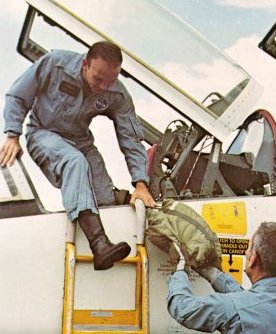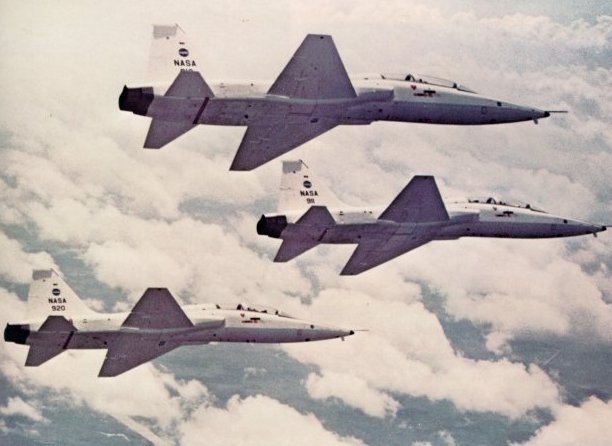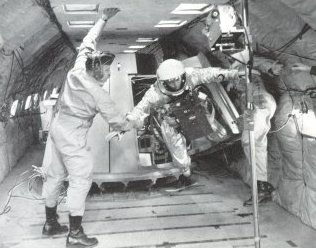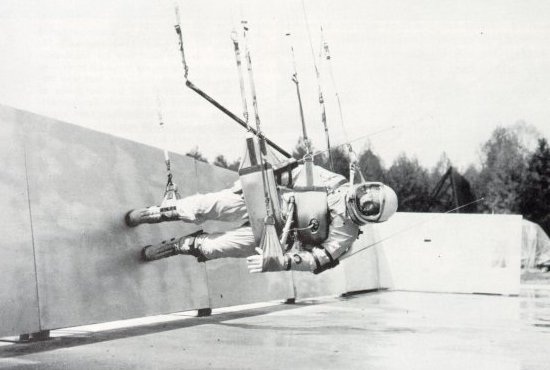Apollo Expeditions to the Moon
CHOOSING THE FIRST MAN ON THE MOON
Once it was fairly certain that Apollo 11 was it, newspaper reporters and some
NASA officials predicted that Aldrin would be the first man to step on the Moon.
The logic was that in Gemini the man in the right-hand seat had done the EVA, and
the early time line drawn up in MSC's lower engineering echelons showed him dismounting
first. But the LM's hatch opened on the opposite side. For Aldrin to get out
first it would have been necessary for one bulky-suited, back-packed astronaut to climb
over another. When that movement was tried, it damaged the LM mockup. "Secondly,
just on a pure protocol basis", said Slayton, "I figured the commander ought to be
the first guy out ... I changed it as soon as I found they had the time line that showed
that. Bob Gilruth approved my decision." Did Armstrong pull his rank, as was widely
assumed? Absolutely not, said Slayton. "I was never asked my opinion", said Armstrong.
"It was fine with me if it was to be Neil", Aldrin wrote, half-convincingly.
Five days before he sent McDivitt and White on that 1965 midnight ride to
Paris, Lyndon B. Johnson had thrown a monkey wrench into the Pentagon's machinery
by jubilantly announcing that he was promoting those astronauts, both Air Force
officers, from major to lieutenant colonel (he didn't bother to find out that both had
only recently made major). The astronauts were naturally delighted.
| | |
A constant companion to an Astronaut during
his training was the graceful twin-engined T-38,
a two-seat jet that was fine for aerobatics.
T-38's were handy for the incessant travel - to
California, New York, the Cape, and way stations - that
was called for by the policy of
involving astronauts in spacecraft development.
And to men who had in the main been expert
test pilots, the agile T-38 was both a means of
keeping sharp and a resource offering privacy
and pleasure. |

|
Mike Collins, left, lands after an exhilarating
session of aerobatics. The T-38 was useful not
just as a means of keeping piloting skills fine-honed
but also to keep up g-load tolerances
and inner-ear response to weightlessness. Plenty
of flight hours before launch seemed to reduce
the tendency toward nausea during initial exposure
to weightlessness during spaceflight.
|
In justice to Maj. Virgil Grissom USAF and Lt. Comdr. John Young USN, who
had flown Gemini 3 three months earlier, the President accelerated promotions for
them, too, again without saying anything to NASA or the Defense Department. He also
went back and picked up some unpromoted Mercury astronauts. Admiral W. Fred
Boone, NASA's liaison officer to the Pentagon, noting "some dissatisfaction both
among the astronaut community and in the Pentagon", undertook a study. Wrote
Boone: "We agreed it would be preferable that meritorious promotions be awarded
in accordance with established policy rather than on a 'spur of the moment' basis."
The upshot was a policy, approved by the President, providing that each military
astronaut be promoted after his first successful flight, but not beyond colonel USAF
or captain USN. Civilians would be rewarded by step increase in civil service grade.
Only one promotion to any individual.
That policy came unstuck on Apollo 12, flown by three Navy commanders,
Pete Conrad, Dick Gordon, and Alan Bean. Conrad and Bean, having been upped
from lieutenant commander to commander after their Gemini 11 flight, were ineligible
for another promotion. Rookie Bean was. But should Bean be promoted over the
heads of his seniors? Hang the policy, said President Nixon, promoting all three.
| | |
A parabolic flight path in a jet transport could create
up to 30 seconds of zero gravity, enough to practice
exit through a spacecraft hatch (above). Two earthbound
simulations of reduced or zero gravity are shown
at right and below. Wearing pressure suits carefully
weighted to neutral buoyancy, astronauts in a big water
tank learn the techniques needed to work effectively in
space. Below, ingenious slings are supported by wires
running to a trolley high above. The angled panels on
which the man walks or runs are offset just enough from
directly under the trolley to simulate the sixth of Earth
gravity that prevails on the Moon.
|
Of all the amenities accruing to astronauts, the hard cash came from "the Life
contract". Between 1959 and 1963 Life magazine paid the Seven Original astronauts
a total of $500,000 for "personal" stories - concerning themselves and their
families - as opposed to "official" accounts of their astronautical
duties. This arrangement
increased the astronauts' military income by about 200 percent. It also simplified NASA
public relations, since the famous young men's bylines would be concentrated in one
place and the contract called for NASA approval of whatever they said.
There were drawbacks. The rest of the press took a sour view of what it considered
public property being put up for exclusive sale (the dividing line between
"personal" and "official" was wafer-thin). Since the same ghostwriters put their
stories in print, the astronauts (and their families) all seemed shaped in the same
mold, utterly homogenized for the greater glory of home, motherhood, and the space
program. "To read it was to believe we were the most simon-pure guys there had
ever been", wrote Buzz Aldrin in Return to Earth. "The contract almost guaranteed
peaches and cream, full-color spreads glittering with harmless inanities", was the way
Mike Collins's book had it.
|





